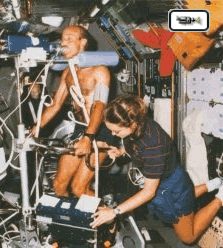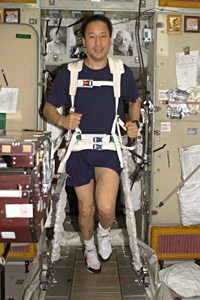Exercising to Stay Healthy

The Spacelab Life Sciences -1 experiments revealed the extent of muscle deterioration in space and the importance of reducing these effects (All Systems Go!). We now know that the best and only way to reduce the impacts of the effects of microgravity is through a rigorous exercise schedule. There are many devices and techniques that have already been developed specifically for exercise in microgravity and are in use now. The equipment allows astronauts to use and exercise muscles that they would not normally use in microgravity. This rigorous exercise schedule is part of a series of experiments designed to fully understand how the human body changes in microgravity (Microgravity).
The extensive and comprehensive exercise program tested during Skylab missions provided promising results. Weight loss was prevented, leg strength and volume was somewhat maintained, and the strength of the muscular system was somewhat retained. Results from the experiments revealed that the astronauts will need to exercise at least two hours per day doing things like riding an exercise bicycle, walking on a treadmill, stretching, and doing resistance training. Mineral supplements and proper diets will also help to alleviate the diminishing effects of microgravity.
The extensive and comprehensive exercise program tested during Skylab missions provided promising results. Weight loss was prevented, leg strength and volume was somewhat maintained, and the strength of the muscular system was somewhat retained. Results from the experiments revealed that the astronauts will need to exercise at least two hours per day doing things like riding an exercise bicycle, walking on a treadmill, stretching, and doing resistance training. Mineral supplements and proper diets will also help to alleviate the diminishing effects of microgravity.
Solutions to the Problems

The first step to solving the problems caused by microgravity is to understand them. The Human Research Facility was developed in the late 1990s to study the effects of microgravity and learn more about the human body by observing it in microgravity (International). If these objectives are focused onto how the human body is affected by microgravity, I believe we will gain a much greater understanding of the problem. I suggest a rigorous monitoring of as many of the physiological symptoms on the astronaut’s body as possible. Hopefully, this will shed a lot of light onto the battle against the harmful effects of microgravity.
I propose a two part experiment: the first part being a barrage of physiological tests to closely and precisely monitor the progression of the microgravity effects and the second part being a centrifuge experiment involving an astronaut. Using the Human Research Facility Rack developed at Johnson Space Center, we can start part one of the experiment. Using equipment already researched and deemed appropriate by NASA, body systems and functions will be monitored. This equipment includes: an Activity Monitor to monitor the quality of sleep, an Ambulatory Data Acquisition System to pool basic physiological data like body temperature, blood pressure, and respiration, an ultrasound system to monitor blood flow, a Hand Grip Dynamometer to measure hand strength, a Space Linear Acceleration Mass Measurement device to measure weight, and other instruments to collect blood, urine, saliva and other bodily fluid samples. These will all be employed to help improve our knowledge (International). If these experiments are repeated as frequently as possible, then a huge amount of valuable information will be collected. Using all of this data, exercise regiments and astronaut’s diets can all be improved to ensure the greatest benefits to the human body.
The biggest application of all of the data collected will be in a human centrifuge experiment. After scientists and engineers are able to design a build a moderately sized centrifuge that can house some basic exercise equipment, we can send it up to the International Space Station to begin experiments. I first propose taking two astronauts of similar body type, weight, and physical build to be the test subjects. One astronaut will do all the exercises and tests mentioned in the first part of the experiment, and the second astronaut will do the same thing, except he’ll be in the centrifuge in an Earth-like gravitational environment. Using the equipment to monitor the physiological symptoms, we’ll be able to monitor how working out and exercising in a gravitational environment affects the astronaut versus the one who exercises in space.
The astronaut who exercised and trained in centrifuge should show drastically reduced effects of microgravity, if they are not nonexistent. If this is the case, then we have just made huge progress in the quest to counteract the effects of microgravity. Over time, repeated experiments will yield even more data that the scientist, doctor, and astronauts can use to refine an exercise regimen that will take full advantage of the centrifuge, allowing astronauts to be as healthy as possible when they return to Earth, and when they also arrive at other planets in the not so distant future.
The problems microgravity cause are extremely serious and before we can look beyond our own planet for travel, we must first learn how to preserve ourselves in space so that when we arrive at whatever our destination is, we’ll be nearly as strong as when we left Earth. By monitoring the effects of microgravity, and eventually using a centrifuge to test its ability to combat those effects, one day we will be able to virtually neutralize microgravity and
unlock the key to long term space flight.
I propose a two part experiment: the first part being a barrage of physiological tests to closely and precisely monitor the progression of the microgravity effects and the second part being a centrifuge experiment involving an astronaut. Using the Human Research Facility Rack developed at Johnson Space Center, we can start part one of the experiment. Using equipment already researched and deemed appropriate by NASA, body systems and functions will be monitored. This equipment includes: an Activity Monitor to monitor the quality of sleep, an Ambulatory Data Acquisition System to pool basic physiological data like body temperature, blood pressure, and respiration, an ultrasound system to monitor blood flow, a Hand Grip Dynamometer to measure hand strength, a Space Linear Acceleration Mass Measurement device to measure weight, and other instruments to collect blood, urine, saliva and other bodily fluid samples. These will all be employed to help improve our knowledge (International). If these experiments are repeated as frequently as possible, then a huge amount of valuable information will be collected. Using all of this data, exercise regiments and astronaut’s diets can all be improved to ensure the greatest benefits to the human body.
The biggest application of all of the data collected will be in a human centrifuge experiment. After scientists and engineers are able to design a build a moderately sized centrifuge that can house some basic exercise equipment, we can send it up to the International Space Station to begin experiments. I first propose taking two astronauts of similar body type, weight, and physical build to be the test subjects. One astronaut will do all the exercises and tests mentioned in the first part of the experiment, and the second astronaut will do the same thing, except he’ll be in the centrifuge in an Earth-like gravitational environment. Using the equipment to monitor the physiological symptoms, we’ll be able to monitor how working out and exercising in a gravitational environment affects the astronaut versus the one who exercises in space.
The astronaut who exercised and trained in centrifuge should show drastically reduced effects of microgravity, if they are not nonexistent. If this is the case, then we have just made huge progress in the quest to counteract the effects of microgravity. Over time, repeated experiments will yield even more data that the scientist, doctor, and astronauts can use to refine an exercise regimen that will take full advantage of the centrifuge, allowing astronauts to be as healthy as possible when they return to Earth, and when they also arrive at other planets in the not so distant future.
The problems microgravity cause are extremely serious and before we can look beyond our own planet for travel, we must first learn how to preserve ourselves in space so that when we arrive at whatever our destination is, we’ll be nearly as strong as when we left Earth. By monitoring the effects of microgravity, and eventually using a centrifuge to test its ability to combat those effects, one day we will be able to virtually neutralize microgravity and
unlock the key to long term space flight.
